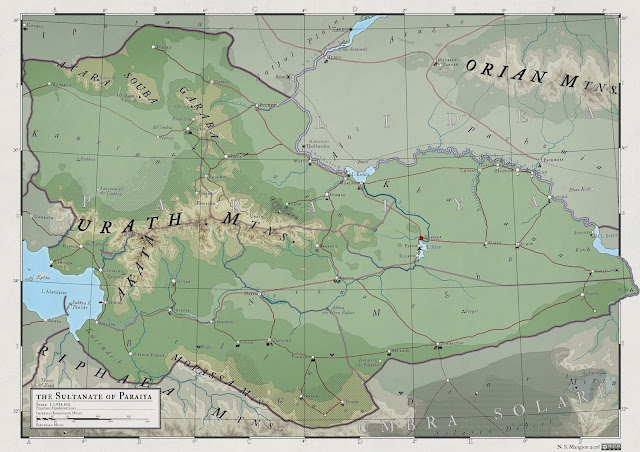I'm also doing an AMA (ask me anything) on reddit about my world. If anyone is interested in asking anything, please head on over there and go ahead and ask me anything :)
 |
| Atlas Elyden #15 - Paraiya |
* * *
Paraiya is a land that has evolved under two shadows - that of Korachani colonists who settled the region between 1200 - 1400 RM, abandoning it to the Domnitors between 2700 - 2800 RM; and the Atramentally-active region that dominates lands to the south of the nation, known as the Umbra Solare.
Situated North of the Tropic of Rah, the climate is semi-arid to arid-temperate, and were it not for the many rivers that flow through its lands the region would be largely uninhabited (indeed the name Paraiya roughly translates to ‘Many Rivers’). The ancient people of Paraiya adapted to the harsh climate by constructing bulbous wattle towers that collect condensation in large quantities and surrounded their cities like silent sentinels. Though not as common as they once were they can still be seen in smaller settlements that are cut off from the more urbane population centres. This is just one of many examples of the ingenuity of the Paraiyan people.
Extant Paraiyan history begins in 73 RM when an exiled prince, Abir Paria settled the region now known for the ruin of the Ebon Palace. His birthplace remains unknown, though his familial name would later become the name of the confederacy of cities that he founded. The region Abir settled was centred on a ruin of black stone that to this day was shunned by the nomads that roam Paraiya, becoming the capital of a confederacy of city-states that emerged by 300 RM.
By 1150 RM, increased Koachani influence across the Paraiyan borders caused tension within the city-states, leading to a period of hostility and warfare between the city-states, whittling down the once prosperous people of Paria, leaving whole regions and cities in ruins. As the open caste mines of the Korachani city of Beluan grew, so did it become more influential. In 2132 RM the Ebon Palace was sacked by descendants of the Pariayan nomadic caste, the Dynasty of Paria left without heir, the conflict at an end.
Their resources spent, their homes destroyed, the remaining people left the area, either populating the lands to the north west, around the river Nothiya, or returning to the semi-nomadic lifestyle they had enjoyed before the rise of Paria, giving rise by c. 2300 RM to the three tribes of the Paraiya – the Arena, Belln and Kharan – which remain largely unchanged to this day.
Korachani colonists abandoned the region between 2700 - 2800 RM, leaving Beluan and other cities in the hands of the Domnitors who would rule as caretakers in their absence. The Domnitors were forgotten by Korachan and over generations they mingled with the upper-classes of Beluan, forming a ruling caste that over the next 1000 years would come to dominate the lands of old Paria, Paraiya as we know it was born. The city of Sopora was resettled in 2750 RM by this ruling caste as a capital. This new ruling caste clashed with the then capital of Bakkou which was the centre of a traditionalist nation that abhorred the memory of the imperial occupation tried to stifle aspects of its culture that had remained (including religion, which has ousted traditional gods in many regions, especially in Sopora). This clash of cultures was most blatant by viewing the lower classes in each city. In Bakkou those of korachani descent were treated as lower class citizens, where in Sopora it was those descended from the nomads who were seen as unclean.
Frictions escalated into civil war in 3792 RM, which dragged on for 2 decades until 3813 RM, with Bakkou losing and the city being sacked. A ruling Sultanate emerged in 3821 in Sopora, which struggles to this day to unify the region.
Travel within Paraiyan territories is hostile and most merchant caravans are armoured and guarded against nomadic attacks. Most people do not see the outside of their cities or their immediate environs. The nomads who proliferate the north west are allies of Karakhas, and the subjects of the Sultanate trade north with Mharokk and Lidea, which are loose allies. The nomads are themselves only loosely connected and still exist in three separate tribes, with members meeting on the winter solstice to revere ancient traditions.
#paraiya, #atlaselyden, #elyden, #fantasycartography

No comments:
Post a Comment